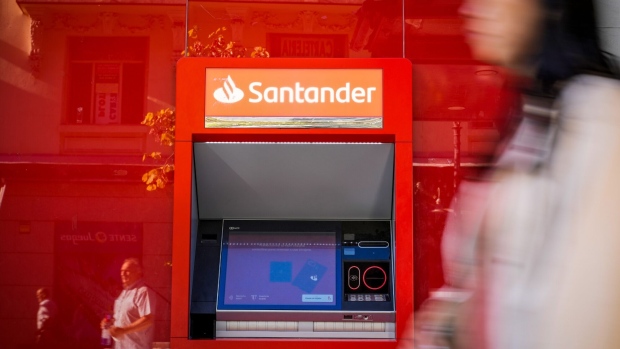Jan 31, 2024
Santander Beats Estimates as New Customers Lift Lending Income
, Bloomberg News

(Bloomberg) -- Banco Santander SA forecast higher revenue and profitability this year after new customers helped lift income from lending in the final months of a record year for the lender.
The Madrid-based lender posted net income of €2.93 billion ($3.17 billion) in the fourth quarter, beating the €2.56 billion forecast by analysts in a Bloomberg poll. Profit for the quarter and the year were the highest on record.
Santander set a target for mid-single digit revenue growth this year as well as a return-on-tangible-equity of 16%, compared with 15.06 last year. It also sees its efficiency ratio below 43%, compared with 44.1% in 2023.
Spain’s largest bank benefited from 5 million new customers added last year, which helped lift net interest income by 9.5% from a year earlier. Santander and its Spanish rivals, who are all highly reliant on retail clients, were among the largest beneficiaries of the European Central Bank’s record rate hiking cycle last year. As the ECB hits the brakes, these same lenders are starting to feel the slowdown in interest income.
On Tuesday, Santander’s largest Spanish peer, Banco Bilbao Vizcaya Argentaria SA, reported net interest income well below expectations, as did Bankinter SA earlier this month. Better than expected fees and commissions helped BBVA offset that decline.
Santander Chairman Ana Botin, speaking in an interview with Bloomberg TV, said she expects Latin America including Mexico to help offset any weakness in the European retail business this year.
The “global economy overall will be softer,” she said. “But for us, it’s going to be a better year.”
Shares of Santander rose 2% at 9:10 a.m. in Madrid, with analysts highlighting the increased profitability target. At the same time, they said the better-than-expected profit reflected largely a tax impact.
What Bloomberg Intelligence Says:
Santander’s 11% beat to consensus 4Q net income is of low quality — driven mostly by one-time tax incentives relating to electric-vehicle leasing — with net income missing estimates by double digits in its key Spain, Brazil and US markets. The bank’s 16% return on tangible equity target in 2024 (vs. sub-15% MODL estimates) faces challenges, including slowing revenue growth and a rising cost of risk.
— Lento Tang, banking analyst
Santander’s 11% 4Q Profit Beat Doesn’t Warrant 2024 Goals: React
Falling interest rates reduce what banks can charge for loans, while funding costs such as interest paid on deposits tend to be slower to come down. One exception to that rule is Brazil, one of its largest markets, where Santander is able to cut payments on deposits faster than lending rates.
Outside Spain, Santander and BBVA also suffered the impact of the Argentine peso’s devaluation following the election of President Javier Milei in November. The South American currency is down more than half against the euro since Milei took office in December.
To help reduce reliance on interest income and build out fees, Botin has been hiring in its corporate and investment bank, particularly in the US. Although the Madrid-based firm was already planning in 2022 to expand in the country, it gained speed after thousands of Credit Suisse employees found themselves looking for jobs when UBS Group AG took over its rival.
For investors, the earnings also offered an initial glimpse of the financial impact of the new corporate structure, which will has a more business-focused reporting rather than a geographical-focus. The company now has five global business groups.
(Adds chairman’s comments from sixth paragraph, shares in eighth. A previous version of this story corrected the increase in net interest income.)
©2024 Bloomberg L.P.






